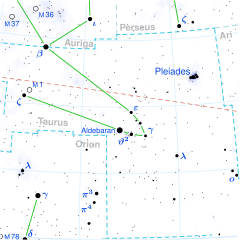ο Tauri, Latinized as Omicron Tauri, is a binary star system in the constellation Taurus, near the constellation border with Cetus. It has a yellow hue and is visible to the naked eye with an apparent visual magnitude of 3.61.[2] It is approximately 270 light years from the Sun based on parallax,[5] but is drifting closer with a radial velocity of −20 km/s.[4] As the westernmost bright point of light in Taurus, this system has the Flamsteed designation 1 Tauri; Omicron Tauri is the Bayer designation.[1]
| Observation data Epoch J2000.0 Equinox J2000.0 | |
|---|---|
| Constellation | Taurus |
| Right ascension | 03h 24m 48.79832s[1] |
| Declination | +09° 01′ 43.9306″[1] |
| Apparent magnitude (V) | 3.61[2] |
| Characteristics | |
| Spectral type | G6 III[3] |
| B−V color index | +0.887±0.019[2] |
| Astrometry | |
| Radial velocity (Rv) | −19.79±0.06[4] km/s |
| Proper motion (μ) | RA: −67.04 mas/yr[5] Dec.: −78.04 mas/yr[5] |
| Parallax (π) | 12.11 ± 0.87 mas[5] |
| Distance | 270 ± 20 ly (83 ± 6 pc) |
| Absolute magnitude (MV) | −1.23[6] |
| Orbit[7] | |
| Period (P) | 1654.9 d |
| Eccentricity (e) | 0.26 |
| Periastron epoch (T) | 2429974.34 JD |
| Argument of periastron (ω) (secondary) | 155.6° |
| Semi-amplitude (K1) (primary) | 4.4 km/s |
| Details[6] | |
| ο Tauri A | |
| Mass | 3.21±0.12 M☉ |
| Radius | 20.28±3.66 R☉ |
| Luminosity | 302[8] L☉ |
| Surface gravity (log g) | 2.43±0.06 cgs |
| Temperature | 5,094±15 K |
| Metallicity [Fe/H] | −0.13±0.02 dex |
| Rotational velocity (v sin i) | 3.29±0.61 km/s |
| Age | 324+39 −35 Myr |
| Other designations | |
| Database references | |
| SIMBAD | data |
This is a single-lined spectroscopic binary[7] system with the two components orbiting each other over a period of 4.53 years with an eccentricity of 0.263.[9] The visible component is an aging G-type giant with a stellar classification of G6 III.[3] This star has three times the mass of the Sun and 20[6]–18 times the Sun's radius. Based on the latter, interferometry-measured radius, it is rotating once every 533 days.[10] It is radiating 302[8] times the luminosity of the Sun from its photosphere at an effective temperature of 5,094 K.[6]
References
edit- ^ a b c d "omi Tau". SIMBAD. Centre de données astronomiques de Strasbourg. Retrieved 2019-10-10.
- ^ a b c Anderson, E.; Francis, Ch. (2012), "XHIP: An extended hipparcos compilation", Astronomy Letters, 38 (5): 331, arXiv:1108.4971, Bibcode:2012AstL...38..331A, doi:10.1134/S1063773712050015, S2CID 119257644.
- ^ a b Keenan, Philip C.; McNeil, Raymond C. (1989), "The Perkins catalog of revised MK types for the cooler stars", Astrophysical Journal Supplement Series, 71: 245, Bibcode:1989ApJS...71..245K, doi:10.1086/191373.
- ^ a b Brown, A. G. A.; et al. (Gaia collaboration) (August 2018). "Gaia Data Release 2: Summary of the contents and survey properties". Astronomy & Astrophysics. 616. A1. arXiv:1804.09365. Bibcode:2018A&A...616A...1G. doi:10.1051/0004-6361/201833051. Gaia DR2 record for this source at VizieR.
- ^ a b c Van Leeuwen, F. (2007). "Validation of the new Hipparcos reduction". Astronomy and Astrophysics. 474 (2): 653–664. arXiv:0708.1752. Bibcode:2007A&A...474..653V. doi:10.1051/0004-6361:20078357. S2CID 18759600. Omicron Tauri's database entry at VizieR.
- ^ a b c d Deka-Szymankiewicz, B.; Niedzielski, A.; Adamczyk, M.; Adamów, M.; Nowak, G.; Wolszczan, A. (2018-07-01). "The Penn State - Toruń Centre for Astronomy Planet Search stars. IV. Dwarfs and the complete sample". Astronomy and Astrophysics. 615: A31. arXiv:1801.02899. Bibcode:2018A&A...615A..31D. doi:10.1051/0004-6361/201731696. ISSN 0004-6361. Omicron Tauri's database entry at VizieR.
- ^ a b Pourbaix, D.; Tokovinin, A. A.; Batten, A. H.; Fekel, F. C.; Hartkopf, W. I.; et al. (2004), "SB9: The ninth catalogue of spectroscopic binary orbits", Astronomy & Astrophysics, 424 (2): 727–732, arXiv:astro-ph/0406573, Bibcode:2004A&A...424..727P, doi:10.1051/0004-6361:20041213, S2CID 119387088.
- ^ a b Luck, R. Earle (25 August 2015). "Abundances in the Local Region. I. G and K Giants". The Astronomical Journal. 150 (3): 88. arXiv:1507.01466. Bibcode:2015AJ....150...88L. doi:10.1088/0004-6256/150/3/88. Omicron Tauri's database entry at VizieR.
- ^ Jackson, E. S.; et al. (May 1957), "The Orbits of the Spectroscopic Binaries Omicron Tauri, Xi Cancri, and Mu Ursae Majories", Astrophysical Journal, 125: 712, Bibcode:1957ApJ...125..712J, doi:10.1086/146345
- ^ Setiawan, J.; et al. (July 2004), "Precise radial velocity measurements of G and K giants. Multiple systems and variability trend along the Red Giant Branch", Astronomy and Astrophysics, 421: 241–254, Bibcode:2004A&A...421..241S, doi:10.1051/0004-6361:20041042-1
External links
edit- Kaler, James B. (March 20, 2009), "Omicron Tauri", STARS, retrieved 2019-10-10.
